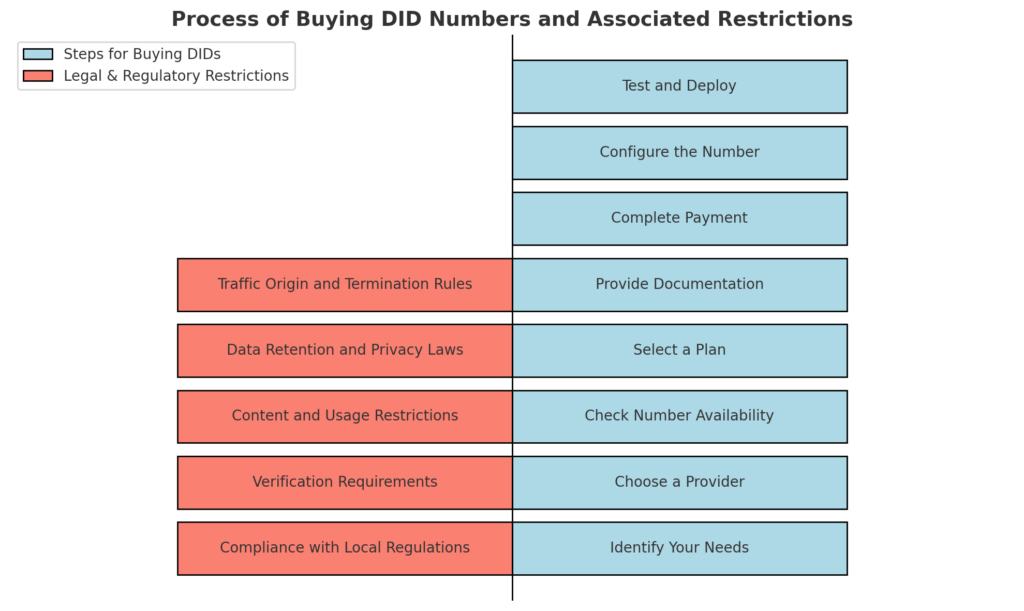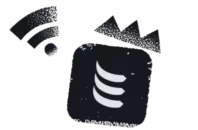“DID” stands for “direct inward dialing” (also known as direct dial-in, or DDI, in some countries). It’s the internet telephony industry’s term for the real-world telephone number each customer needs to accept calls through standard telephone systems.
In practice, these numbers are all controlled by a central writer, and each one has to be paid for. Below, we outline the DID number buying process and help you decide on the right service for your needs.
The Process of Purchasing DID Numbers

Here’s a step-by-step overview of how buying DID numbers typically works:
- Identify Your Needs:
- Determine the region or country for which you need the DID number.
- Decide the type of number (local, toll-free, mobile).
- Assess your usage scenario (voice calls, SMS, fax).
- Choose a Provider:
- Compare DID providers based on pricing, features, and global coverage.
- IDT Express, for instance, is a popular choice due to its vast inventory of global DIDs and seamless integrations.
- Check Number Availability:
- Providers usually offer online tools to search for and reserve available DID numbers in your preferred region.
- Select a Plan:
- Choose a pricing plan based on usage volume, duration, and features (e.g., SMS, voicemail, call recording).
- Confirm if the plan is pay-as-you-go or subscription-based.
- Provide Documentation:
- Many countries require businesses to provide proof of identity, business registration, or a local address to comply with telecom regulations.
- Complete Payment:
- Make the payment for the number and any additional features or credits.
- Configure the Number:
- Set up call forwarding, IVR (Interactive Voice Response), or integration with your PBX or CRM system.
- Test and Deploy:
- Test the DID number to ensure functionality and deploy it in your workflows.
Legal and Regulatory Restrictions in Buying DIDs
DID purchasing involves several legal and rule-based restrictions, depending on the country and use case.
Key considerations include:
- Compliance with Local Regulations:
- Some countries require a local presence (address or registration) for using local DID numbers.
- Toll-free and emergency numbers may have stricter allocation policies.
- Verification Requirements:
- Governments may mandate identity verification to prevent misuse (e.g., proof of identity, company registration).
- Content and Usage Restrictions:
- DIDs cannot be used for spam, fraud, or illegal activities. Violating these rules can lead to penalties or service termination.
- Data Retention and Privacy Laws:
- Providers must comply with laws like GDPR (in the EU) or CCPA (in California) regarding call recording or data usage.
- Traffic Origin and Termination Rules:
- Some countries regulate how traffic can originate or terminate through their telecom networks, affecting call routing.
DID Number Buying vs Traditional Telephone Number Identities
To understand exactly how DID number buying functions, it’s important to understand how phone systems have evolved.
The traditional phone network is colloquially known as POTS, which stands for the “plain old telephone system.” Under the conventions of POTS, numbers only need to be unique within each area code. So, someone in Miami might have the same telephone number as someone in Los Angeles. However, adding the area code makes each of those numbers unique.
Nearly every country has its own telephone number writer, though there are some exceptions, as some countries share country codes. The International Telecommunication Union (ITU), an agency of the United Nations, allocates country and region codes under a plan called E.164. The plan doesn’t have any requirements about how each country or country code zone organizes its pool of numbers; the only stipulation is that no telephone number should be more than 15 digits in length.
Country and Area Codes
The United States is one of a handful of countries that doesn’t have its own country code. The code that the USA uses, “1,” is shared by several neighbouring countries, including Canada and Caribbean nations, including the Dominican Republic.
In the US, each area code is three digits long, and each number within that area code is seven digits in length. If you place many calls, you’ll quickly become familiar with different locations based on their area codes alone. For example, 305 is in Miami. Area code 304 applies to West Virginia, and code 306 applies to the province of Saskatchewan in Canada – clearly, you can’t work out where an area code is through proximity.
Cell phone area codes in many countries, such as the UK, are separate from the landline-based area codes and do not relate to specific locations. In the US, however, cell phones are given distinct central office codes (the first three digits of the local number), but use the same area codes as landline telephones.
All US telephone numbers originate with the US North American Numbering Plan Administration (NANPA), which is part of the Federal Communications Commission (FCC). NANPA allocates telephone numbers in blocks of 10,000 or, sometimes, on request, in blocks of 1,000.
Only registered telecom companies can gain access to those blocks of numbers. Telecom companies buy these blocks to allocate to their customers. DID number providers, on the other hand, take up blocks of numbers from NANPA and sell them in smaller groups to internet telephony providers, making DID numbers accessible to consumers and businesses.
DID Numbers for Business
The fact that a DID number gives you a presence in a specific location through its associated area code can be a big advantage for businesses.
If you want to attract customers in another country, you may face an uphill struggle, as people may not want to pay international call rates to reach you – and they may not trust calls from international numbers. However, if you buy a DID number in that country and have all calls routed through to your office PABX, it will appear as if you’re local. Callers to the DID number will then be charged based on the number’s area code; they won’t be charged to forward that call to your real location.
The use of DID numbers can also combat prejudices that may be inadvertently created when certain area codes are perceived as being more valuable than others. Because DID numbers hide your real location, you can lock down a number that appears to originate in a prestigious district while running your offices in more remote areas where you can access both lower rents and workers whose lower costs of living produce lower wage expectations.
DID numbers are particularly useful for businesses that operate offshore call centers, as they can periodically and automatically switch the destination of calls to a DID number. This makes it possible to forward calls to offices in different time zones at different times of the day, facilitating around-the-clock service without requiring employees to work at night.
Choosing the Right DID Provider

If you’re an end-user, you may not be able to choose your DID provider directly. DID numbers are sold to VoIP service companies and traditional telecom companies, and it is those businesses that you’d contact to sign up for service. While setting up your account, you’ll be able to select the quantity of virtual numbers needed, as well as their area codes.
If having vanity numbers that spell out a word on a keypad or 1-800 toll free numbers is important to you, make sure any VoIP service or telecom provider you’re considering makes them available. If not, your main task becomes deciding which country and area code you want your number to be in.
Consumer Choice
If you research a company and find that it doesn’t have the telephone numbers in the areas you need, then you probably won’t open an account with that service. Realistically, when you reject a VoIP or traditional telecom service, you also reject its associated DID number provider.
In some cases, a service provider may not have access to the numbers you want initially, but may be able to source them immediately through an account with another DIDs provider. So if you’re set on one particular company, but it doesn’t appear as if they offer the functionality needed, it’s always worth asking before ruling them out as an option.
Companies offering DID numbers choose their providers based on several different factors, including the availability of numbers and the process by which they’re provisioned. Although price is always a factor, number range should hold a big influence as well. Don’t assume that, just because one VoIP or traditional telecom service doesn’t provide the DIDs you need, others will fail to deliver as well.
Using a DID Number
VoIP and telecom services don’t allocate DID numbers directly to your phone. Instead, after signing up, you’ll generally get access to an online console, through which you’ll be able to choose where and how to allocate the number.
For example, if you allocate your DID number to a computer, you should then be able to use your computer’s microphone and speaker to make and answer calls. If anyone dials into that number, the call should be routed to an app on your computer.
You may also be able to install an app on your mobile device in order to pick up incoming calls. If you have both your computer and phone turned on at the same time, the incoming call should cause the app to ring in both, so that you can choose which of them will answer the call.
Ultimately, using these methods should feel like using a standard telephone—just as you did with the POTS service.





One Response
SONO UN’AGENZIA IMMOBILAIRE, VORREI ACQUISTARE 2000 CONTATTI DI NUMERI TELEFONICI (CELLULARE) PER INVIARE PUBBLICITA’ SU WHATSAPP.
ATTENDO PREVENTIVO.
GRAZIE
SALUTI
ROSSANA